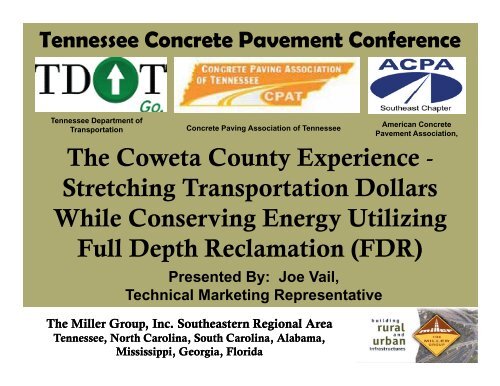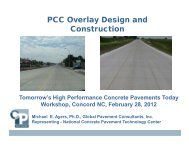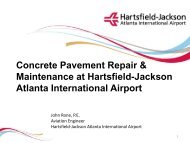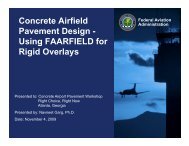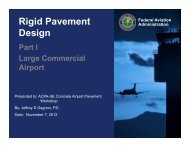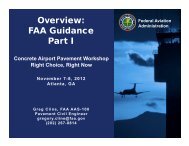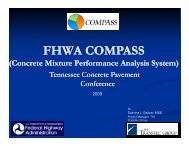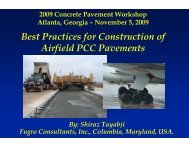Full-Depth Reclamation using Cement - American Concrete ...
Full-Depth Reclamation using Cement - American Concrete ...
Full-Depth Reclamation using Cement - American Concrete ...
- No tags were found...
You also want an ePaper? Increase the reach of your titles
YUMPU automatically turns print PDFs into web optimized ePapers that Google loves.
Tennessee <strong>Concrete</strong> Pavement ConferenceTennessee Department ofTransportation<strong>Concrete</strong> Paving Association of Tennessee<strong>American</strong> <strong>Concrete</strong>Pavement Association,The Coweta County Experience -Stretching Transportation DollarsWhile Conserving Energy Utilizing<strong>Full</strong> <strong>Depth</strong> <strong>Reclamation</strong> (FDR)Presented By: Joe Vail,Technical Marketing RepresentativeThe Miller Group, Inc. Southeastern Regional AreaTennessee, North Carolina, South Carolina, Alabama,Mississippi, Georgia, Florida
Conference Goals:• Provide educational Opportunities• Provide Ways to meet the increasing demandfor safe, durable and cost-effective pavements.
Presentation Outline• Coweta County Background• Driving Forces Behind Choosing FDR• Technical• Economical• Social – Environmental• FDR Equipment and Project Pictures• Summary
IntroductionHow many of you look at this road as a liability?
Coweta County, GeorgiaCounty ProfileCities and Towns• Georgia’s 67th County• Newnan (County Seat)• Incorporated: June 9, 1825 • Grantville • Moreland• Population: 100,000 • Haralson • Senoia• Total Area: 443.1 Square miles • Sharpsburg • Turin
By Maintaining and ImprovingInfrastructure To Support Growth For:Population: 100,000(2010)
Coweta County Development andEngineering DepartmentWorks to Achieve The Goals Of“The Joint ComprehensiveTransportation Plan”
By Developing & Approving FundingFor Transportation ti Projects That:• Recognize Roads were not built for today’s traffic volumes• Costs for transportation projects are increasing• State and Federal dollars are shrinking• Local government has to find ways to fund these projects: Theyestablished a Special Purpose Local Option Sales Tax (SPLOST)SPLOST is a voter approved 1 cent sales tax in place for a specifiedtime. SPLOST revenues must be spent on capital projects. The currentCoweta SPLOST is in place until 2012 and creates revenues in excess$ 20,000,000 of the overall $ 30,800,000.00 Budget• Provides a Transportation Budget of 57% of the overall Budget thatconsists of over $17,500,000.00000 • Capital Improvement Projects were outlined to build and reconstructthe infrastructure for the existing and future needs of Coweta County
Infrastructure To Support The Existing andFuture Needs for:BusinessesLocal HospitalsCommunity ShoppingAreasRoads To AccessCommercial Properties
Infrastructure To Support The Existing andFuture Needs for:Residential NeighborhoodsMultifamily NeighborhoodsRural NeighborhoodsResidential Neighborhoods
Infrastructure To Support The Existing and FutureNeeds for:Community SchoolsAuditoriums/ ParksCommunity Athletic Parks/Green Complexes AreasChurchesCommunity Parks/Tourist AttractionstiEquestrian Trails/Greenways
Methods Used In ReconstructingThe Coweta County Infrastructure t Are:• Conventional Patch Design– 440 lbs/sy 19mm Asphalt Patch– 65lbs/sy 4.75mm Leveling– 1.5” 12.5mm Asphalt Surface• Alternative FDR Design– 8” FDR Pulverization & <strong>Cement</strong>– 1.5” 12.5mm Asphalt Surface
Principles Driving FDR
What is FDR?<strong>Full</strong> <strong>Depth</strong> <strong>Reclamation</strong> (FDR) is a pavement rehabilitation technique inwhich the full flexible pavement section and a predetermined portion ofthe underlying materials are uniformly pulverized and blended together toproduce a stabilized base course (SBC); additional structural strength maybe obtained through the use of additives.
Technical Benefits Using FDR• Increased Rigidity• Eliminates Rutting BelowSurface• Reduced MoistureSusceptibility• Reduced Fatigue Cracking• Retards ReflectiveCracking• Re-establish profile• Thinner Pavement Section
Increased Rigidity SpreadsLoads100 psi 100 psi4 psi15 psi<strong>Full</strong>-<strong>Depth</strong> <strong>Reclamation</strong>Unstabilized Granular Base
Eliminates Rutting BelowSurfaceUnstabilized Base<strong>Full</strong> <strong>Depth</strong> <strong>Reclamation</strong> BaseRutting can occur in surface,base and subgrade ofunstabilized bases due torepeated wheel loading<strong>Full</strong> depth reclamation bases resistconsolidation and movement, thusvirtually eliminating rutting in alllayers but the asphalt surface.
Reduced Moisture SusceptibilityUnstabilized Granular BaseHigh water table<strong>Full</strong> <strong>Depth</strong> <strong>Reclamation</strong> BaseMoisture infiltrates base:• Through high water table• Through capillary action• Causes softening, lower strength, andreduced modulus<strong>Full</strong> <strong>Depth</strong> <strong>Reclamation</strong>:• Reduces permeability• Helps keep moisture out• Maintains high level of strength andstiffness even when saturated
Reduced Fatigue CrackingAsphaltSurfaceUnstabilized BaseHigh deflection due tolow base stiffnessResults in high surface strainsand eventual fatigue cracking<strong>Full</strong> <strong>Depth</strong> <strong>Reclamation</strong> BaseHigher stiffness offull depth reclaimedbase produces lowerdeflectionsResulting in lowersurface strains andlonger pavement life
Retards Reflective Cracking
Mill and Fill
<strong>Full</strong> <strong>Depth</strong> <strong>Reclamation</strong>
Thinner Pavement Section1.5” Asphalt Surface65lbs/sy Asphalt Leveling4” Asphalt Patch5.5” Existing BaseWith Unstable Areas1.5” Asphalt Surface8” of Reclaimed BaseWith <strong>Cement</strong>Compacted SubgradeCompacted SubgradePatch DesignFDR Design
Build-up of Cohesion
Build-up of Cohesion
Cohesive LayerBridge Effect
Structural Comparison – Patch DesignLayerCoeff.SNLayerCoeff.SN1.5” Asphalt Surface65lbs/sy Asphalt Leveling0.44 2.681.5” Asphalt Surface65lbs/sy Asphalt Leveling0.44 0.924” Asphalt Patch5.5” Existing BaseWith Unstable Areas0.10 0.559.5” Existing BaseWith Unstable Areas0.10 0.95Compacted Subgrade3.23 1.87Compacted Subgrade33% of Road Patched 67% of road un-patched33% @ 3.23 + 67% @ 1.87 = 2.32 Effective SN
Structural Comparison –FDR DesignLayerCoeff.SN1.5” Asphalt Surface0.44 0.668” of Reclaimed BaseWith <strong>Cement</strong>030 0.30 240 2.403.06Compacted Subgrade
Overall Structural Comparison1.5” Asphalt Surface65lbs/sy Asphalt Leveling4” Asphalt Patch5.5” Existing BaseWith Unstable Areas1.5” Asphalt Surface8” of Reclaimed BaseWith <strong>Cement</strong>Compacted SubgradeCompacted SubgradePatch Design SN = 2.32FDR Design SN = 3.0632% INCREASEIN STRENGTH
Value of This Road Material is:• This road isactually an asset• Using FDR it isat least worth it’sweight in GAB• 1 mile = $112k !
DIRECT COST OF FDR(EXCLUDING TRAFFIC CONTROL)• Initial Construction Cost of FDR DesignFor 1Mile14,080 SY4 year average 8” FDR with <strong>Cement</strong> is $ 8.37/sy = $ 17,85015” 1.5 12.5mm Asphalt Surface is $ 6.19/sy = $ 87,150TOTAL FDR COST PER MILE (14,080sy)@ $14.56/sy = $ 205,000• Long-term Maintenance Expense (15 years)Resurface (1) times in 15 YearsCrack Seal @ $1,500/Mi = $ 1,50014,080sy of Leveling Asph. @ $2.40/SY = $ 33,79214,080sy of 12.5 Asph. @ $6.19/SY = $ 87,155TOTAL 15 yr MAINTENANCE COST PER MILE = $122,447
DIRECT COST OF PATCH(EXCLUDED TRAFFIC CONTROL)• 4 year average cost of 440lbs/sy Patch= 21.04/sy• Initial Construction Cost For Patching 4,000sy 28%of 1Mile – 14,080 syPatch 28% of 1 Mile of roadway - 4,000 sy @ $ 21.04 = $ 84,00065lbs/SY 4.75mm Leveling 14,08 @ $ 2.40/sy = $ 34,0001.5” 12.5mm Asphalt Surface @ $ 6.19/sy = $ 87,155TOTAL With 28% of 1 Mile Patched = $ 205,000• LONG TERM MAINTENANCE N NC EXPENSE(15years)Resurface (2) times in 15 Years2Mile of Crack Seal @ $1,500/Mi = $ 3,000Patch 50% of Road every 7 Years due to base failures = $ 296,2442Mile of 28,160 sy of Leveling Asph. @ $2.40/sy = $ 67,5842Mile of 28,160 sy of 12.5 Asph. @ $6.19/sy = $ 174,311TOTAL = $ 541,139
15-Year Cost ComparisonInitiali 15-yearTotalNet PresentConstruction MaintenanceValueCostFDR Design 205,000 122,447 327,440 252,979PATCH 28%Design205,000 541,139 746,139 498,423NOTE: IF ROAD NEEDS MORE THAN 28 % PATCHED – COST SAVING ARESEEN IN THE INITIAL CONSTRUCTION STAGE$245,444 444 per mile savingsA 10 mile annual program saves $2.45M
Social Benefits• Conserves natural resources – materials il are100% recycled• Use an asset that is already bought and paid for– your roadway!• Haulage of material on and off site isdrastically reduced• Shorter construction durations minimize trafficdisruption and congestion• Heating of materials is not required therebysignificantly reducing energy consumption
New Roadway vs. FDR ComparisonTrucks(Number)Material (tons)123001806200Landfill (cy)Diesel (gal)050027003000FDRNew1 Mile of 24’-wide 2-lane road
Energy Consumption
Energy Consumption800700Laydow nTransport600Manufacture500400AggregateBinder(MJ/tonne)300200Energy100HMAHMA with20% RAPBind nder Course<strong>Concrete</strong>Graded Aggre regate Base0Cold In-Plac ce Recycling<strong>Full</strong> <strong>Depth</strong> h<strong>Reclamation</strong>Source: The Environmental Road for the Future, Life Cycle Analysis(Colas Group 2003, p.34)
Energy ConsumptionProcessMJ/tonnekg/tonneUS Gal./tonHot Mix Asphalt68017.84.26Hot Mix Asphalt (20% RAP)53814.13.38Binder Course59115.53.72<strong>Concrete</strong>73819.34.62Graded Aggregate Base1133.00.72Cold in-place Recycling139369 3.69088 0.88<strong>Full</strong> <strong>Depth</strong> <strong>Reclamation</strong>812.10.50Source: The Environmental Road for the Future, Life Cycle Analysis(Colas Group 2003, p.34)
Profile Correction• Possible corrective e operations– cut & fill– profiling the roadway before the treatment, <strong>using</strong> one ormore of:• importing material (generally for major longitudinalprofile adjustments or gradation correction)• milling• full depth – pulverizationProposed roadwaytransverse profileCL
- Improving StabilityChoose Additives For:- Permanent Strength Increase - Long -Term Strength Gains- Less Moisture Absorption - Freeze -Thaw Durability
Choosing An Additive• Obtain representative ti samples of thein-situ materials from the site• Perform Laboratory Tests– Sieve Analysis (ASTM C136)– Atterberg Limits (ASTM D4318)– Sand Equivalent (ASTM D2419B) if abituminous additive is being considered• Utilize flow charts and other toolsto determine the additive options &Develop a mix design– examples on following slides
Suggested Additives for Various Aggregate Bases and Soils (03/06)Soil TypeWellgradedgravelPoorlygradedgravelSiltygravelClayeygravelWellgradedsand*PoorlygradedsandSiltysandClayeysandSilt, SiltwithsandLeanclayOrganicsilt /organicleanclayElasticsiltFat clay,fat claywithsandUSCS GW GP GM GC SW SP SM SC ML CL OL MH CHAASHTO A-1-a A-1-a A-1-b A-1-b A-1-b A-3 or A-2-4 A-2-6 A-4 or A-6 A-4 A-5 or A-7-6orA-2-6A-1-b orA-2-5orA-2-7A-5A-7-5Fortress®FDR / GBSBest ifSE > 25andP200 < 20*FoamedasphaltP200 10 to20% andfollow max.density grad.PortlandcementPI10 andP20025,SO 4 in clay 30 andP200>25%ProsProject / materialselection,engineered mixdesign/emulsion,same day returnto traffic, quickoverlaySame day returnto traffic, ,quickoverlayQuick set, highstrength,compatible withmany soilsQuick set, highstrength (withclay-containingsoils)Same as lime*Some projects that do not meet these material recommendations have been successfully built * Some projects that do not meet these material recommendation have beensuccessfully builtConsCan not handlehigh claycontenttSafety, mayrequire cement /lime, gradationsensitive,maintain highasphalttemperaturePrime & sandreq’d fortraffictraffic,dust, earlycracking, littleoverlay bondingDust, earlycracking,potential sulfateheaveSame as lime
Portland <strong>Cement</strong>-100-90-80poor zone for cementstabilizationti% SILT and CLAY“Portland <strong>Cement</strong> is probably the closest thing wehave to a universal stabilizer.”- From a U.S. Army Corps of Engineers Report dated September 2002-70-60-50-40-30-20-10-0
Perceived Barriers of FDR• Equipment size inconfined urban areas• Working under traffic• Ahi Achieving i the desireddcurb reveal• Lowering and raisingof utility structures• Controlling Dust
FDR Equipment
FDR Equipment
FDR Equipment
FDR Equipment
• Recycling equipment– Reclaimer/stabilizer - full depthtreatment– Granulation of in-place material– Separate the aggregate particles fromone another
Pre-pulverize & Blend Existing Asphaltwith Underlying GAB & MaintainTraffic With Pilot Vehicle
Pre-pulverize & Blend ExistingAsphalt with Underlying GAB
Rough Grade BlendedMaterial And Compact
Equipment & Construction• Compactors & compaction– Recycled material - high internal friction– Large rollers (pneumatic and vibrant)– Role of water is critical¼”Laminating Effect of Compaction
Material Management• Achieving i desired d curb reveal really a material managementexercise• Pre-milling should be avoided• do not want to take away the most valuable material ($$$ &material properties)• Pre-pulverization method is preferred• Remove excess blended material after pulverization process
Remove Surplus Material
Fine Grade Stabilized MaterialAnd Compact
Achieving CompactionAt Pavement Edge
Achieving Desired Curb Reveal• Must consider desired d curb reveal at allstages of the recycling process• Examples of consistent curb revealReady for 2”Overlay Ready for 4”Overlay
Final Recycled ProductMaintain Moisture For Curing
Maintain Moisture ContentWhile Curing
Install Temporary Centerline DelineationMarkers To Maintain Traffic Flow DuringNon Construction PeriodsAllow To Cure Under Traffic
Lowering/AdjustingUili Utility Structures• Initially, the lowering of all structuresseemed overwhelming• This process now completed safely andefficiently• Must keep accurate record of structurelocations (both documented and in the field)
Locating & Lowering/RaisingStructuresMaintenance hole lowered belowgrade prior to pulverization process
Final Adjustment and Compaction
Quality ControlCheck Spread Rate Per Mix DesignCheck Spread Rate Per Mix Design
Quality Control
Quality ControlDensity / Moisture
Quality ControlThickness<strong>Cement</strong> Contentt(Phenolphthalein)
Quality ControlStiffnessStability
Summary• Benefits– Technical:• excellent long term performance is provided– Economical:• cost of pavement rehabilitation/construction is reduced– Social:• impact on the environment is minimizedi i • energy savings• heating of material is not required• haulage of material on or off site is minimized– Ability to work in urban sections & profile correction• Driving engine– The top layers of the existing roadway are a source ofaggregate and binder that is reused to create a newpavement layer & they are already bought and paid for
Don’t Remove andReplace ItREUSE IT(<strong>Full</strong> <strong>Depth</strong> <strong>Reclamation</strong>)FDR


